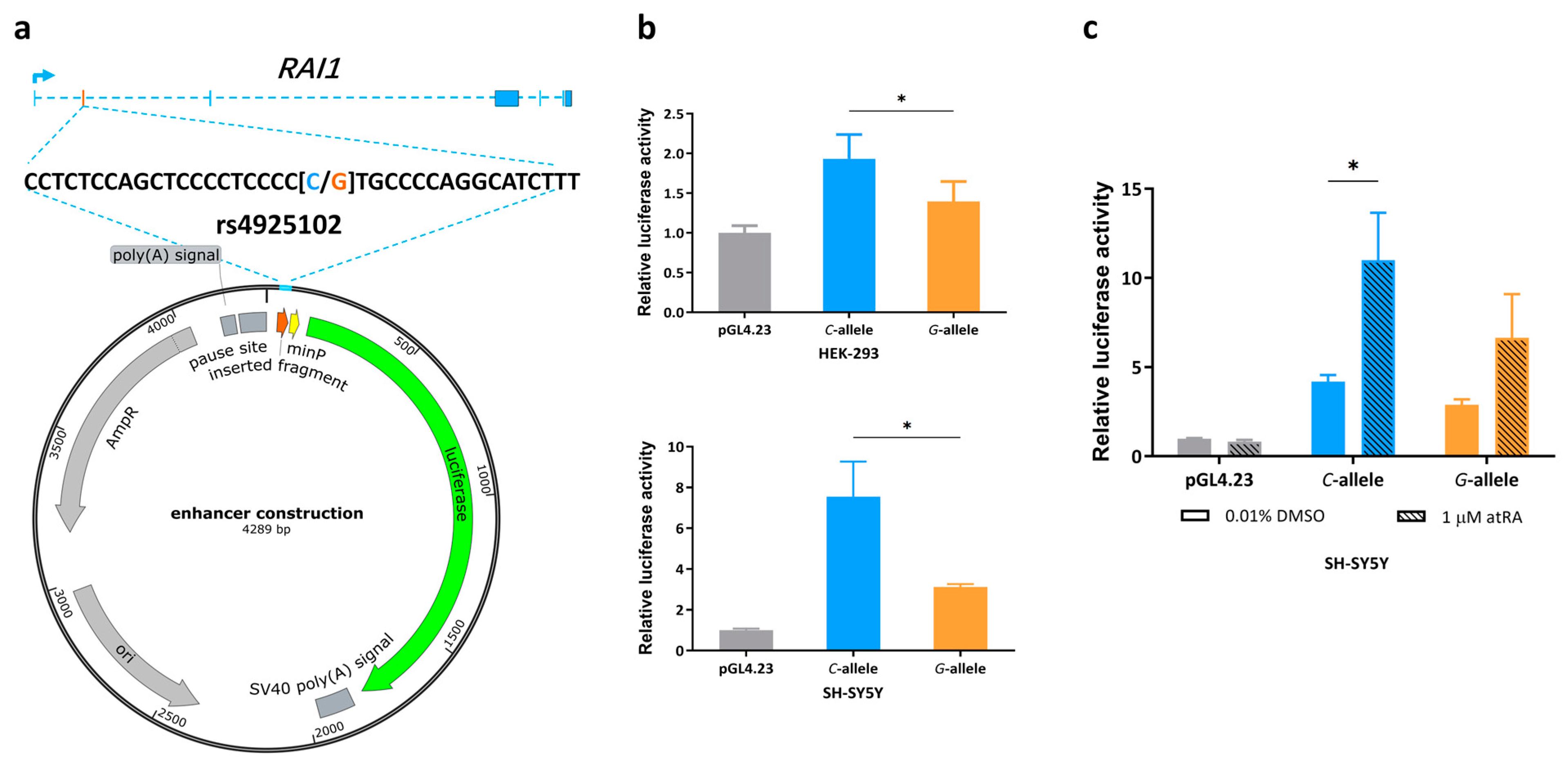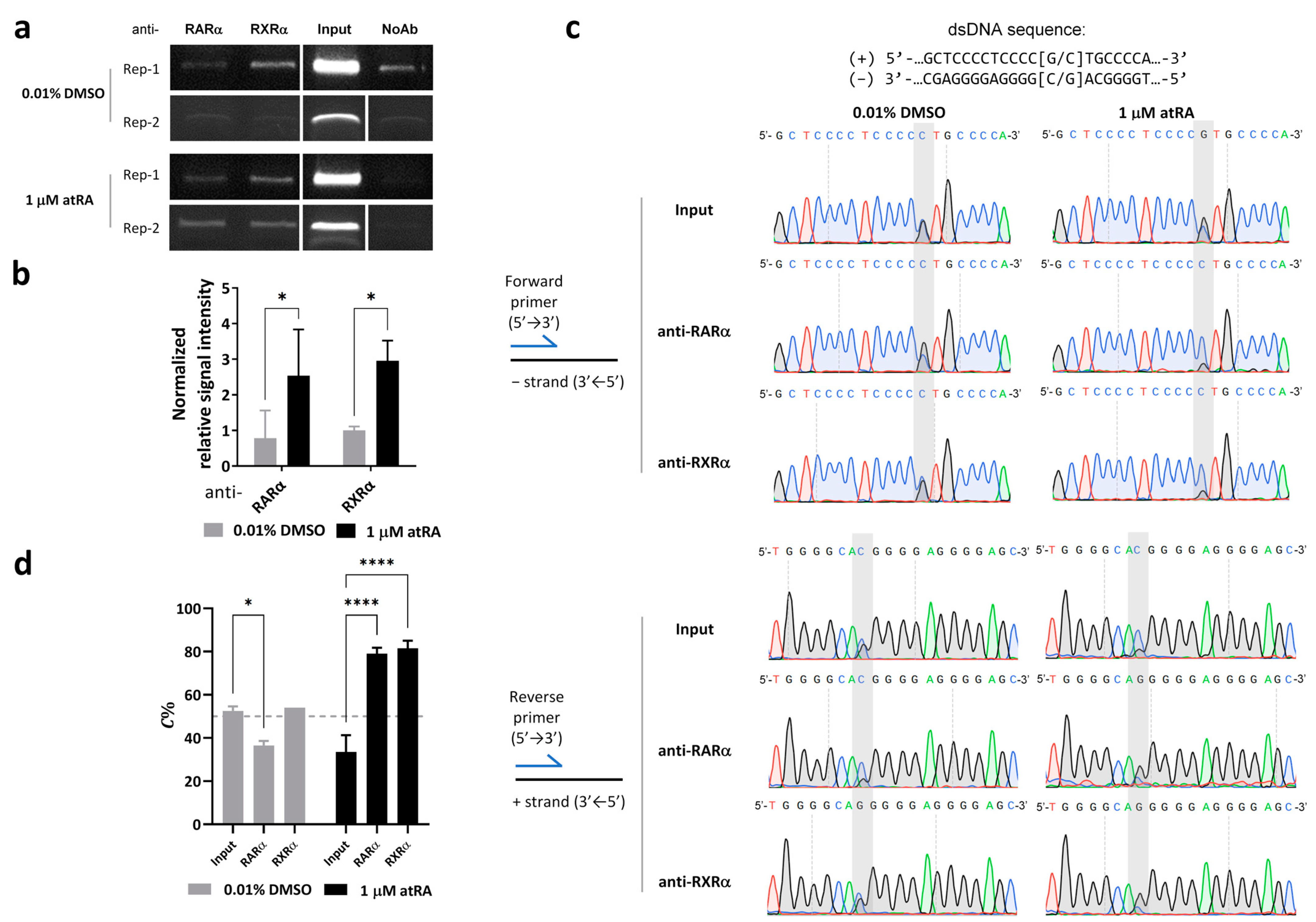Allele-Specific Regulation of the Candidate Autism Liability Gene RAI1 by the Enhancer Variant rs4925102 (C/G)
Abstract
1. Introduction
2. Materials and Methods
2.1. Cell Culture
2.2. atRA Induction
2.3. Plasmid Construct
2.4. Luciferase Reporter Assay
2.5. Chromatin Immunoprecipitation (ChIP) Assays
2.6. Quantification of Immunoprecipitated Chromatin Containing rs4925102 C- or G-Alleles
2.7. Chromatin Conformation Capture, 3C
2.8. Statistics
2.9. Samples
2.10. Imputation
2.11. Association Analysis
3. Results
3.1. Gene Expression Is Regulated by SNP Rs4925102 in an Allele-Specific Manner
3.2. Allelic Effects of Rs4925102 on Luciferase Reporter Gene Expression by All-Trans Retinoic Acid (atRA)
3.3. Preference of RARα/RXRα Binding Switches from the G- to C-Allele in the Presence of 1 μM atRA
3.4. The rs4925102 DNA Region Is in Close Physical Proximity to the RAI1 Promoter in SH-SY5Y Cells with or without Exposure to atRA but Undergoes a Dramatic Change in Association with a Downstream Site within the RAI1 Gene following Exposure to atRA
3.5. Autism Spectrum Disorder (ASD) Case-Control and Transmission Disequilibrium Test (TDT) Studies of rs4925102
4. Discussion
Supplementary Materials
Author Contributions
Funding
Institutional Review Board Statement
Informed Consent Statement
Data Availability Statement
Conflicts of Interest
References
- Chang, Y.-T.; Lee, Y.-J.; Haque, M.; Chang, H.-C.; Javed, S.; Lin, Y.C.; Cho, Y.; Abramovitz, J.; Chin, G.; Khamis, A.; et al. Comparative Analyses of the Smith-Magenis Syndrome Protein RAI1 in Mice and Common Marmoset Monkeys. J. Comp. Neurol. 2024, 532, e25589. [Google Scholar] [CrossRef] [PubMed]
- Falco, M.; Amabile, S.; Acquaviva, F. RAI1 Gene Mutations: Mechanisms of Smith-Magenis Syndrome. Appl. Clin. Genet. 2017, 10, 85–94. [Google Scholar] [CrossRef] [PubMed]
- Rinaldi, B.; Villa, R.; Sironi, A.; Garavelli, L.; Finelli, P.; Bedeschi, M.F. Smith-Magenis Syndrome-Clinical Review, Biological Background and Related Disorders. Genes 2022, 13, 335. [Google Scholar] [CrossRef] [PubMed]
- Zhang, F.; Potocki, L.; Sampson, J.B.; Liu, P.; Sanchez-Valle, A.; Robbins-Furman, P.; Navarro, A.D.; Wheeler, P.G.; Spence, J.E.; Brasington, C.K.; et al. Identification of Uncommon Recurrent Potocki-Lupski Syndrome-Associated Duplications and the Distribution of Rearrangement Types and Mechanisms in PTLS. Am. J. Hum. Genet. 2010, 86, 462–470. [Google Scholar] [CrossRef] [PubMed]
- Bissell, S.; Wilde, L.; Richards, C.; Moss, J.; Oliver, C. The Behavioural Phenotype of Potocki-Lupski Syndrome: A Cross-Syndrome Comparison. J. Neurodev. Disord. 2018, 10, 2. [Google Scholar] [CrossRef] [PubMed]
- Laje, G.; Morse, R.; Richter, W.; Ball, J.; Pao, M.; Smith, A.C.M. Autism Spectrum Features in Smith-Magenis Syndrome. Am. J. Med. Genet. C Semin. Med. Genet. 2010, 154C, 456–462. [Google Scholar] [CrossRef] [PubMed]
- Neira-Fresneda, J.; Potocki, L. Neurodevelopmental Disorders Associated with Abnormal Gene Dosage: Smith-Magenis and Potocki-Lupski Syndromes. J. Pediatr. Genet. 2015, 4, 159–167. [Google Scholar] [CrossRef] [PubMed]
- Hirota, T.; King, B.H. Autism Spectrum Disorder: A Review. JAMA 2023, 329, 157–168. [Google Scholar] [CrossRef] [PubMed]
- Huang, W.-H.; Guenthner, C.J.; Xu, J.; Nguyen, T.; Schwarz, L.A.; Wilkinson, A.W.; Gozani, O.; Chang, H.Y.; Shamloo, M.; Luo, L. Molecular and Neural Functions of Rai1, the Causal Gene for Smith-Magenis Syndrome. Neuron 2016, 92, 392–406. [Google Scholar] [CrossRef]
- Chen, L.; Tao, Y.; Song, F.; Yuan, X.; Wang, J.; Saffen, D. Evidence for Genetic Regulation of mRNA Expression of the Dosage-Sensitive Gene Retinoic Acid Induced-1 (RAI1) in Human Brain. Sci. Rep. 2016, 6, 19010. [Google Scholar] [CrossRef]
- Boyle, A.P.; Hong, E.L.; Hariharan, M.; Cheng, Y.; Schaub, M.A.; Kasowski, M.; Karczewski, K.J.; Park, J.; Hitz, B.C.; Weng, S.; et al. Annotation of Functional Variation in Personal Genomes Using RegulomeDB. Genome Res. 2012, 22, 1790–1797. [Google Scholar] [CrossRef] [PubMed]
- Dong, S.; Zhao, N.; Spragins, E.; Kagda, M.S.; Li, M.; Assis, P.; Jolanki, O.; Luo, Y.; Cherry, J.M.; Boyle, A.P.; et al. Annotating and Prioritizing Human Non-Coding Variants with RegulomeDB v.2. Nat. Genet. 2023, 55, 724–726. [Google Scholar] [CrossRef] [PubMed]
- Luo, T.; Wagner, E.; Dräger, U.C. Integrating Retinoic Acid Signaling with Brain Function. Dev. Psychol. 2009, 45, 139–150. [Google Scholar] [CrossRef]
- Rochel, N.; Moras, D. Architecture of DNA Bound RAR Heterodimers. Subcell. Biochem. 2014, 70, 21–36. [Google Scholar] [PubMed]
- le Maire, A.; Bourguet, W. Retinoic Acid Receptors: Structural Basis for Coregulator Interaction and Exchange. Subcell. Biochem. 2014, 70, 37–54. [Google Scholar]
- Samarut, E.; Rochette-Egly, C. Nuclear Retinoic Acid Receptors: Conductors of the Retinoic Acid Symphony during Development. Mol. Cell Endocrinol. 2012, 348, 348–360. [Google Scholar] [CrossRef]
- Shibata, M.; Pattabiraman, K.; Lorente-Galdos, B.; Andrijevic, D.; Kim, S.-K.; Kaur, N.; Muchnik, S.K.; Xing, X.; Santpere, G.; Sousa, A.M.M.; et al. Regulation of Prefrontal Patterning and Connectivity by Retinoic Acid. Nature 2021, 598, 483–488. [Google Scholar] [CrossRef] [PubMed]
- Krezel, W.; Kastner, P.; Chambon, P. Differential Expression of Retinoid Receptors in the Adult Mouse Central Nervous System. Neuroscience 1999, 89, 1291–1300. [Google Scholar] [CrossRef]
- Glover, J.C.; Renaud, J.-S.; Rijli, F.M. Retinoic Acid and Hindbrain Patterning. J. Neurobiol. 2006, 66, 705–725. [Google Scholar] [CrossRef]
- Wołoszynowska-Fraser, M.U.; Kouchmeshky, A.; McCaffery, P. Vitamin A and Retinoic Acid in Cognition and Cognitive Disease. Annu. Rev. Nutr. 2020, 40, 247–272. [Google Scholar] [CrossRef]
- Chiang, M.Y.; Misner, D.; Kempermann, G.; Schikorski, T.; Giguère, V.; Sucov, H.M.; Gage, F.H.; Stevens, C.F.; Evans, R.M. An Essential Role for Retinoid Receptors RARbeta and RXRgamma in Long-Term Potentiation and Depression. Neuron 1998, 21, 1353–1361. [Google Scholar] [CrossRef] [PubMed]
- Park, E.; Tjia, M.; Zuo, Y.; Chen, L. Postnatal Ablation of Synaptic Retinoic Acid Signaling Impairs Cortical Information Processing and Sensory Discrimination in Mice. J. Neurosci. 2018, 38, 5277–5288. [Google Scholar] [CrossRef]
- Jiang, W.; Yu, Q.; Gong, M.; Chen, L.; Wen, E.Y.; Bi, Y.; Zhang, Y.; Shi, Y.; Qu, P.; Liu, Y.X.; et al. Vitamin A Deficiency Impairs Postnatal Cognitive Function via Inhibition of Neuronal Calcium Excitability in Hippocampus. J. Neurochem. 2012, 121, 932–943. [Google Scholar] [CrossRef]
- Xu, X.; Li, C.; Gao, X.; Xia, K.; Guo, H.; Li, Y.; Hao, Z.; Zhang, L.; Gao, D.; Xu, C.; et al. Excessive UBE3A Dosage Impairs Retinoic Acid Signaling and Synaptic Plasticity in Autism Spectrum Disorders. Cell Res. 2018, 28, 48–68. [Google Scholar] [CrossRef]
- Szatmari, P.; Paterson, A.D.; Zwaigenbaum, L.; Roberts, W.; Brian, J.; Liu, X.-Q.; Vincent, J.B.; Skaug, J.L.; Thompson, A.P.; Senman, L.; et al. Mapping Autism Risk Loci Using Genetic Linkage and Chromosomal Rearrangements. Nat. Genet. 2007, 39, 319–328. [Google Scholar] [PubMed]
- Suarez, B.K.; Duan, J.; Sanders, A.R.; Hinrichs, A.L.; Jin, C.H.; Hou, C.; Buccola, N.G.; Hale, N.; Weilbaecher, A.N.; Nertney, D.A.; et al. Genomewide Linkage Scan of 409 European-Ancestry and African American Families with Schizophrenia: Suggestive Evidence of Linkage at 8p23.3-P21.2 and 11p13.1-Q14.1 in the Combined Sample. Am. J. Hum. Genet. 2006, 78, 315–333. [Google Scholar] [CrossRef] [PubMed]
- Imai, Y.; Suzuki, Y.; Matsui, T.; Tohyama, M.; Wanaka, A.; Takagi, T. Cloning of a Retinoic Acid-Induced Gene, GT1, in the Embryonal Carcinoma Cell Line P19: Neuron-Specific Expression in the Mouse Brain. Brain Res. Mol. Brain Res. 1995, 31, 1–9. [Google Scholar] [CrossRef]
- Hagège, H.; Klous, P.; Braem, C.; Splinter, E.; Dekker, J.; Cathala, G.; de Laat, W.; Forné, T. Quantitative Analysis of Chromosome Conformation Capture Assays (3C-qPCR). Nat. Protoc. 2007, 2, 1722–1733. [Google Scholar] [CrossRef] [PubMed]
- Green, M.R.; Sambrook, J. Cloning Polymerase Chain Reaction (PCR) Products: TA Cloning. Cold Spring Harb. Protoc. 2021, 2021. [Google Scholar] [CrossRef]
- Sandelin, A.; Wasserman, W.W.; Lenhard, B. ConSite: Web-Based Prediction of Regulatory Elements Using Cross-Species Comparison. Nucleic Acids Res. 2004, 32, W249–W252. [Google Scholar] [CrossRef]
- Portales-Casamar, E.; Kirov, S.; Lim, J.; Lithwick, S.; Swanson, M.I.; Ticoll, A.; Snoddy, J.; Wasserman, W.W. PAZAR: A Framework for Collection and Dissemination of Cis-Regulatory Sequence Annotation. Genome Biol. 2007, 8, R207. [Google Scholar] [CrossRef] [PubMed]
- Schoenfelder, S.; Fraser, P. Long-Range Enhancer-Promoter Contacts in Gene Expression Control. Nat. Rev. Genet. 2019, 20, 437–455. [Google Scholar] [CrossRef]
- Zuchegna, C.; Aceto, F.; Bertoni, A.; Romano, A.; Perillo, B.; Laccetti, P.; Gottesman, M.E.; Avvedimento, E.V.; Porcellini, A. Mechanism of Retinoic Acid-Induced Transcription: Histone Code, DNA Oxidation and Formation of Chromatin Loops. Nucleic Acids Res. 2014, 42, 11040–11055. [Google Scholar] [CrossRef] [PubMed]
- Kuznetsova, T.; Wang, S.-Y.; Rao, N.A.; Mandoli, A.; Martens, J.H.A.; Rother, N.; Aartse, A.; Groh, L.; Janssen-Megens, E.M.; Li, G.; et al. Glucocorticoid Receptor and Nuclear Factor Kappa-b Affect Three-Dimensional Chromatin Organization. Genome Biol. 2015, 16, 264. [Google Scholar] [CrossRef] [PubMed]
- Saravanan, B.; Soota, D.; Islam, Z.; Majumdar, S.; Mann, R.; Meel, S.; Farooq, U.; Walavalkar, K.; Gayen, S.; Singh, A.K.; et al. Ligand Dependent Gene Regulation by Transient ERα Clustered Enhancers. PLoS Genet. 2020, 16, e1008516. [Google Scholar] [CrossRef] [PubMed]
- Rinaldi, L.; Fettweis, G.; Kim, S.; Garcia, D.A.; Fujiwara, S.; Johnson, T.A.; Tettey, T.T.; Ozbun, L.; Pegoraro, G.; Puglia, M.; et al. The Glucocorticoid Receptor Associates with the Cohesin Loader NIPBL to Promote Long-Range Gene Regulation. Sci. Adv. 2022, 8, eabj8360. [Google Scholar] [CrossRef] [PubMed]
- Frank, F.; Liu, X.; Ortlund, E.A. Glucocorticoid Receptor Condensates Link DNA-Dependent Receptor Dimerization and Transcriptional Transactivation. Proc. Natl. Acad. Sci. USA 2021, 118, e2024685118. [Google Scholar] [CrossRef] [PubMed]
- Liu, H.; Tsai, H.; Yang, M.; Li, G.; Bian, Q.; Ding, G.; Wu, D.; Dai, J. Three-Dimensional Genome Structure and Function. MedComm 2023, 4, e326. [Google Scholar] [CrossRef]
- Maden, M. Retinoic Acid in the Development, Regeneration and Maintenance of the Nervous System. Nat. Rev. Neurosci. 2007, 8, 755–765. [Google Scholar] [CrossRef]
- Rhinn, M.; Dollé, P. Retinoic Acid Signalling during Development. Development 2012, 139, 843–858. [Google Scholar] [CrossRef]
- Olson, C.R.; Mello, C.V. Significance of Vitamin A to Brain Function, Behavior and Learning. Mol. Nutr. Food Res. 2010, 54, 489–495. [Google Scholar] [CrossRef]



| Test | Sample Size | Minor/Major Allele | OR * (95% Cl) | p-Value | Risk Allele |
|---|---|---|---|---|---|
| TDT | 4076 | G/C | 1.119 (0.997–1.256) | 0.056 | G |
| Case-control | 2477 | G/C | 1.123 (1.002–1.258) | 0.046 | G |
Disclaimer/Publisher’s Note: The statements, opinions and data contained in all publications are solely those of the individual author(s) and contributor(s) and not of MDPI and/or the editor(s). MDPI and/or the editor(s) disclaim responsibility for any injury to people or property resulting from any ideas, methods, instructions or products referred to in the content. |
© 2024 by the authors. Licensee MDPI, Basel, Switzerland. This article is an open access article distributed under the terms and conditions of the Creative Commons Attribution (CC BY) license (https://creativecommons.org/licenses/by/4.0/).
Share and Cite
Yuan, X.; Chen, L.; Saffen, D. Allele-Specific Regulation of the Candidate Autism Liability Gene RAI1 by the Enhancer Variant rs4925102 (C/G). Genes 2024, 15, 460. https://doi.org/10.3390/genes15040460
Yuan X, Chen L, Saffen D. Allele-Specific Regulation of the Candidate Autism Liability Gene RAI1 by the Enhancer Variant rs4925102 (C/G). Genes. 2024; 15(4):460. https://doi.org/10.3390/genes15040460
Chicago/Turabian StyleYuan, Xi, Li Chen, and David Saffen. 2024. "Allele-Specific Regulation of the Candidate Autism Liability Gene RAI1 by the Enhancer Variant rs4925102 (C/G)" Genes 15, no. 4: 460. https://doi.org/10.3390/genes15040460
APA StyleYuan, X., Chen, L., & Saffen, D. (2024). Allele-Specific Regulation of the Candidate Autism Liability Gene RAI1 by the Enhancer Variant rs4925102 (C/G). Genes, 15(4), 460. https://doi.org/10.3390/genes15040460





